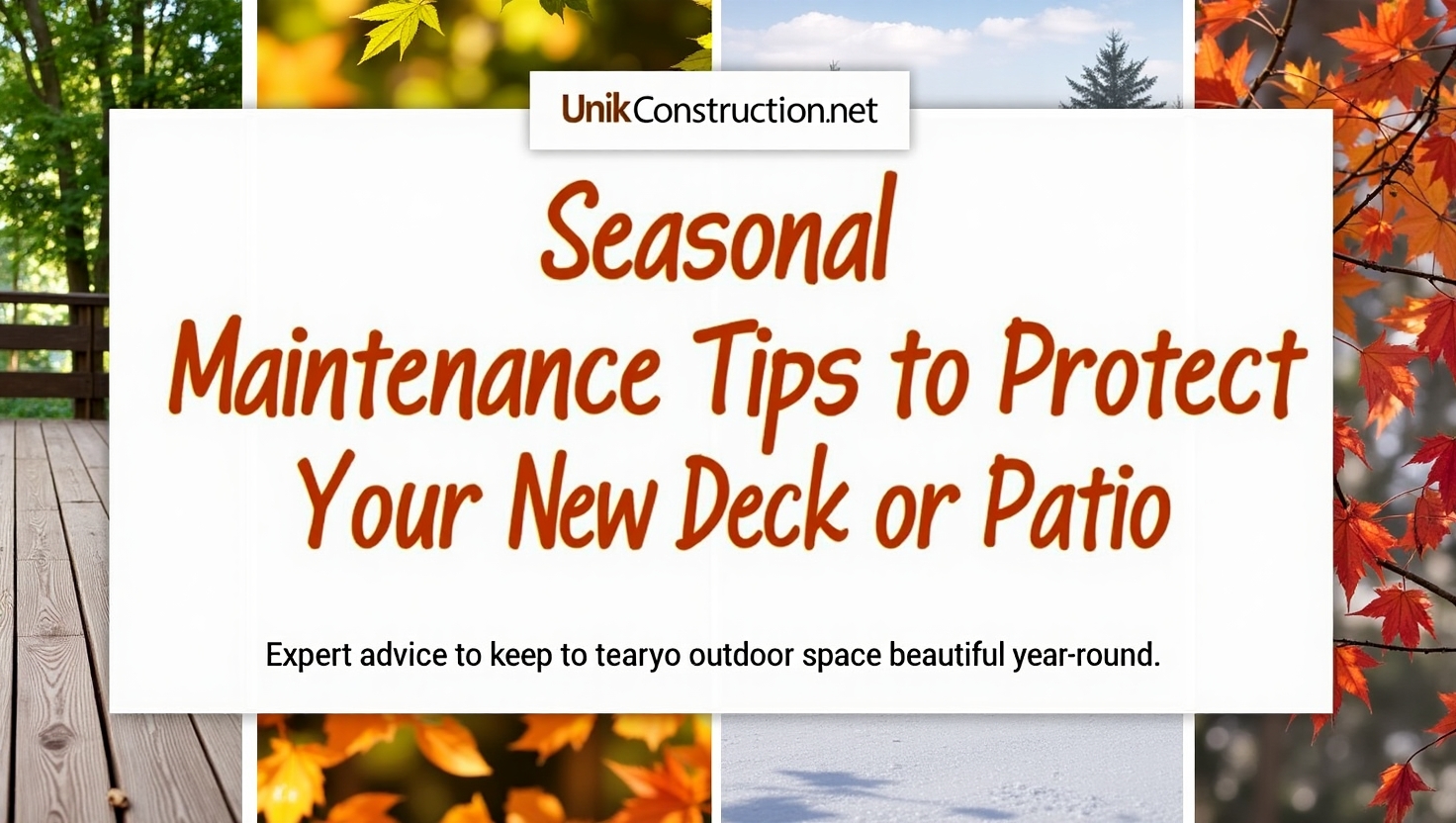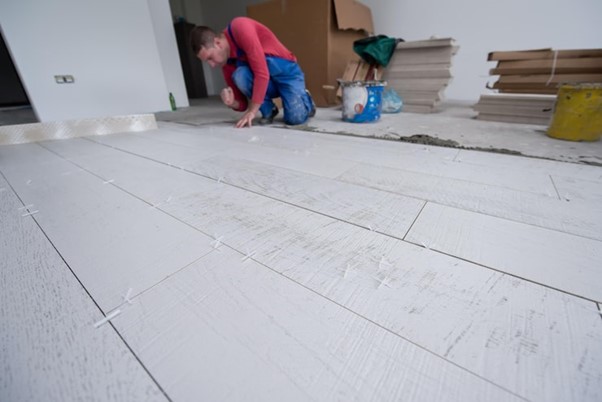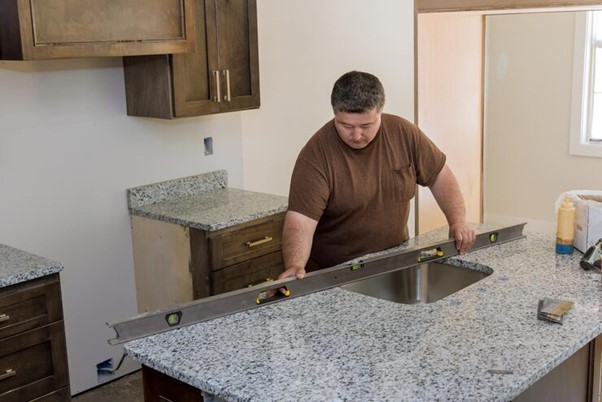There’s nothing quite like stepping out onto a brand-new deck or patio. If it’s your morning coffee spot or the place where summer memories are made, your outdoor space deserves a little care to keep it looking great all year long.
Just like your car or garden, your deck or patio needs some attention as the seasons change. From the heat of summer to the chill of winter, each season brings its own challenges.
But don’t worry, taking care of your outdoor space doesn’t have to be hard. With a few simple tips, you can protect your investment and keep it looking fresh for years to come.
Table of Contents
ToggleSpring: Deep Cleaning & Inspection for Deck Protection
Spring is the best time to reset your outdoor space after winter. Start by sweeping off debris like leaves, branches, and dirt. Use a plastic knife or narrow tool to clear debris between deck boards. For patios, rinse off any surface buildup with water first.
Use a cleaner designed for your deck material—wood, composite, or vinyl. Avoid anything harsh that might strip protective coatings. Let the surface dry fully before moving to the next step.
Once clean, inspect everything closely. Look for water damage, mildew, soft spots, and cracks in boards. Pay attention to fasteners, railings, and stairs. Any shifting or loose connections need to be addressed. This prevents small issues from becoming structural problems.
Check underneath your deck too. Make sure the ledger board, posts, and joists are solid. Rot can start there if moisture’s been trapped all winter.
Do a water test by sprinkling a few drops. If the water soaks in quickly instead of beading on the surface, it’s time to reseal. Spring is also a good time to trim nearby plants or trees that could trap moisture or cause damage later in the season.
A focused inspection and deep clean now sets the stage for better performance in summer—and saves you from larger repairs down the line.
Summer: UV Protection & Busy Season Maintenance
Summer brings the most traffic to your deck or patio—and the most sun. Protecting against heat, UV rays, and moisture buildup is key.
Sweep at least once a week. Food crumbs, plant matter, and grit can stain or wear surfaces over time. Spot clean spills right away with mild soap and water.
Apply a UV-resistant sealant or stain if you don’t do it in spring. This protects against sun bleaching, cracking, and warping. Avoid heavy coatings—stick to breathable options suited to your material.
If your deck gets direct sunlight for most of the day, consider adding shade. A pergola, umbrella, or fabric canopy helps reduce surface temperature and fade. Less direct sunlight means longer-lasting finishes.
Check the space under your deck or around your patio base. Drainage must be clear to prevent moisture buildup, which leads to mildew and rot. Watch for loose nails or screws after heavy use. Addressing these small shifts keeps your deck or patio safe and sturdy all summer.
Fall: Preparing Your Deck and Patio for Winter
Leaves, rain, and temperature swings all pose threats in fall. Start by clearing debris as soon as it falls. Letting wet leaves sit can stain and trap moisture.
Sweep thoroughly and check drainage paths. Water should never pool or flow back toward your home’s foundation.
Inspect for any surface damage. Cracked boards, peeling stain, or rusting fasteners should be addressed immediately to prevent further deterioration during freezing cycles.
Tighten loose railings and check the stair treads. Replace any damaged boards. Fall is also your final chance to seal or stain before winter.
Inspect gutters and downspouts near your patio or deck. Overflowing water can spill onto boards and freeze overnight, which weakens joints and cracks material.
Cover or store furniture if possible. Use breathable covers if you’re leaving them out. Avoid plastic tarps—they trap moisture and can cause mold to form underneath.
With good prep in the fall, your deck or patio will be ready to handle whatever winter throws at it.
Winter: Snow, Ice & Safety Tips
Snow and ice can shorten the life of your deck or patio if handled carelessly. Use a plastic shovel to clear snow, never metal—it scratches and gouges.
Push snow along the boards’ direction instead of across. This avoids catching edges or splitting corners. Remove snow once it hits 3 inches to prevent buildup stress.
Do not use rock salt. It damages wood and corrodes metal fasteners. Opt for calcium chloride-based deicers marked as safe for decks or composite materials.
If ice forms, clean gently and use warm water sparingly to loosen it, but never pour hot water directly, as it can crack frozen materials.
Check for sagging, bending, or moisture pooling in odd spots. These are signs that snow weight or thawing is stressing the structure.
Winter maintenance is all about gentle, low-impact actions that reduce stress on your outdoor surfaces.
Year-Round Best Practices for Deck & Patio
Sweep regularly. This stops dirt buildup and mold growth. Clean spills as soon as they happen, especially oils or food residue. Inspect once every few months. Walk the surface and look underneath. Check fasteners, flashing, and railings.
Every 12 to 18 months, clean and reseal wood decks. Composite and vinyl may need less frequent treatment, but still benefit from a gentle wash and inspection.
Don’t place potted plants directly on wood. Use stands or trays to prevent water stains and rot underneath.
Conclusion
Seasonal deck maintenance is straightforward, but it takes attention. A few hours each season keeps your patio or deck in excellent shape for years. It prevents costly repairs and protects the time and money you’ve already invested.
Discover Unik Construction, which takes a comprehensive approach to every project, handling all the details so you don’t have to. Our team is dedicated to delivering high-quality results with clear communication and expert craftsmanship every step of the way.
Visit us today and let’s start building your dream space.
FAQs (Frequently Asked Questions)
How often should I clean my deck or patio?
Sweep weekly and clean with soap and water at least once per season. Deep clean once a year.
When should I reseal or restain my deck?
If water doesn’t bead on the surface, it’s time. Usually every 1–2 years for wood.
Can I use a pressure washer?
Low pressure only. High pressure can strip the surface or dig into wood. Avoid composite unless recommended by the manufacturer.
What cleaners are safe to use?
Use cleaners made for your material—wood, composite, or vinyl. Avoid bleach or ammonia-based products.
What ice melt is safe for winter?
Use calcium chloride or deck-safe deicers. Avoid rock salt and anything labeled as “driveway” or “sidewalk” melt.






